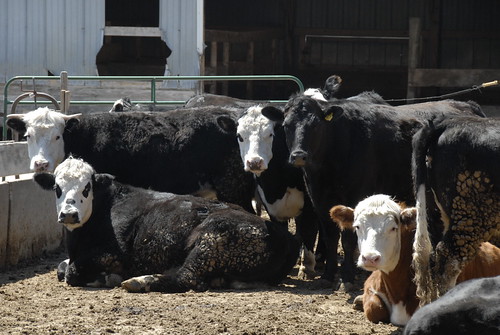不過,瑞典查爾姆斯理工大學的研究顯示,想要繼續吃肉也行,只要把牛肉換成雞肉和蛋,少吃牛奶和起司,也能幫助減緩氣候變遷。
從飲食著手 「以雞代牛」的氣候行動
查爾姆斯理工大學的研究發現,改吃雞肉是改善氣候變遷的行動當中,經濟又有效的方法。
「改變飲食習慣,是減緩食品業氣候衝擊最有效的方法。」Bryngelsson的博士論文主題是檢視土地利用、糧食相關的溫室氣體排放,探討人類飲食習慣的改變將如何影響氣候。
「我的研究顯示,全球改變飲食習慣甚至比從能源和運輸著手更經濟。目前70%的農地用在畜牧牛隻,從飲食上改善能源效率,以雞代牛,可以釋出土地做其他用途,如培養生質能源。」Bryngelsson說。
根據Bryngelsson的研究,素食仍是對氣候最友善的飲食方式,畢竟種植作物生產效率比畜牧家禽家畜要好,但不吃牛可以獲得最佳的改善效益。
不吃牛改吃雞減少的氣候衝擊,比從吃雞改吃全素要多。
牛會反芻 還會吃飼料
生產鏈技術的改善,能減少食品產業造成的氣候衝擊,但牛隻仍然是最大的問題,因為需要大量的飼料餵養,反芻也會排放溫室氣體甲烷,但雞不會反芻。
吃牛肉是惡化氣候變遷的元兇之一。但如今,全世界有著相同的趨勢:人口越來越多,吃下肚的牛肉也越來越多,這跟全球控制暖化於2℃以內的目標背道而馳。
「牛隻畜牧佔人類二氧化碳排放總量的15%。富裕國家人民的飲食習慣,讓達成氣候目標變得更困難。」查爾姆斯理工大學研究人員David Bryngelsson說。
Bryngelsson解釋,為了增加牛隻畜牧數量,人類砍伐越來越多的森林,也不利於氣候。
「我們知道可以用未被利用、較不肥沃的土地來培養生質能源。不過我的研究顯示,地主傾向把高價值的土地也拿來種生質作物,賺得比種蔬菜等重要糧食作物多。」
奶素不如蛋素,不如全素
「吃雞肉等低碳高脂肉類的人,比吃大量奶製品的素食者,更能幫助減緩氣候變遷。」Bryngelsson說。
雞肉生產的碳足跡較小,因為一隻母雞每年可以生產150隻小雞,但每隻母牛1年只能生產大約1隻小牛,而且雞的生長速度很快,又能吸收大部分吃下去的營養。
Bryngelsson也相信,雞隻友善的生產方法越多,氣候效益越大。
至於雞蛋,由於其碳排放密度跟雞肉基本上差不多,因此Bryngelsson的結論是,雞蛋也比牛肉和乳製品更氣候友善。
「可以把雞肉想像成電動車──是個不錯的替代方案,又不會跟我們目前的生活習慣差太多。」
Eating beef is one of the biggest climate villains, but a vegan diet is not necessary to reach climate goals, finds new research from Chalmers University of Technology. A poultry-based diet is a smart and inexpensive way to reduce our impact on the climate.
The trend all over the world is the same: an increasing number of people are eating an increasing amount of beef, although this trend runs counter to the goal of limiting the temperature increase to 2 degrees Celsius as governments agree to do at the UN climate summit in Copenhagen in 2009.
“Cattle ranching is already responsible for 15 percent of the greenhouse gas emissions that humans cause. The diet we are accustomed to in wealthy countries is not consistent with our climate goals,” says Chalmers researcher David Bryngelsson, whose doctoral thesis concerns land use, food related greenhouse gas emissions, and climate change.
He examined how the climate would be impacted if humans were to change their diet. People may have heard that that a vegetable diet results in less greenhouse gases. But Bryngelsson’s research shows that we can continue eating animal protein and still make a major contribution to the climate, if we replace beef with poultry and eggs, and cut down on our consumption of milk and cheese.
“Even people who eat an extremely protein-rich LCHF [Low Carb High Fat] diet with chicken as the base make a greater contribution to the environment than vegetarians who consume a great deal of dairy products,” he said.
Bryngelsson believes that climate gains will prevail even with more chicken-friendly production methods.
Technical improvements in the production chain can reduce the food industry’s climate impact, but cattle are still the biggest problem because they need a lot of feed and release the greenhouse gas methane as they ruminate. Cows belch large amounts of methane while chewing their cud, something chickens do not do.
Forests are disappearing to make room for the increasing number of cattle, which also impacts the climate.
“Changing our consumption is the most effective way to reduce the impact food has on the climate, and my studies show that it would also make it much less expensive to reach climate goals on a global level compared to merely making changes in the energy and transport sector.”
“Since around 70 percent of all agricultural land is currently used to raise cattle, converting to a more energy-efficient diet of poultry would free up land for cultivation of for example bioenergy,” says Bryngelsson, who has also studied that possibility.
“It has been claimed that we can cultivate bioenergy on previously unutilized, less fertile land,” said Bryngelsson. “My models, however, show that this would result in a poorly functioning market, where land owners ultimately earn more by planting bioenergy crops on their prime land instead of using it for our crucial vegetables as is currently the case. We quite simply have to accept that cultivation of bioenergy will compete with food production for prime farming land.”
Bryngelsson’s studies show that a vegan diet is still the most climate-friendly, since plant based food is more efficiently produced than livestock based, but the greatest gains are to be had by discontinuing products from cattle.
The benefits to the climate when moving away from a poultry diet to a vegan diet are relatively minor compared to moving away from cattle to poultry, he says.
“You could say that chicken is like an electrical car – it is a better alternative, yet still very similar to what we are accustomed to.”
There is no doubt that the chicken leaves a smaller carbon footprint regardless of production method. This is because a hen can have around 150 chicks per year as compared to a cow that can give birth to not quite one calf per year, and because chicks grow extremely quickly and thus absorb a greater proportion of their feed.
Intensity of emissions is basically the same for eggs and chicken meat, so Bryngelsson concludes that eggs are also climate smart compared to beef and dairy products.
※ 全文及圖片詳見:ENS









